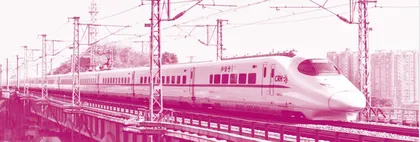Why Are Rail Overhead Lines So Fragile in Face of Wind?高铁接触网为什么在面对风时如此“脆弱”

As an important part of the power source for highspeed trains, the overhead line equipment itself has strong stability, but there are too many light objects floating along the line. These foreign objects are extremely dynamic and difficult to control. Except for some tunnel sections, the railway is an open-air environment.
Kite wires with a metal core are one of the troublemakers that haunt railway workers every year. If one end of the kite wire touches the power supply line and the other end touches the ground, it will cause a short circuit on the overhead lines, causing a loss of power.
Other conductive materials, such as tin foil and iron sheets, could also pose a threat. Although other foreign objects are non-conductive, once they are blown into an overhead line, they may disable trains from getting a current.
In many cases, train workers have to remove foreign objects from overhead lines manually. The bigger the foreign object, the harder it is to clean it up. Bird nests are one of the most difficult.
Due to their height and durability, overhead lines have become a popular site for birds to make a home. Birds carefully arrange their home with branches, iron wires, straw, etc. So,what is their solution? To make fake nests and put them along the railway to trick birds into thinking the place is taken.
作为高铁重要供电来源的接触 网设备,其本身具备较强的稳定性, 但沿线的轻飘物太多。这些外来物 动态性极强,特别不好控制。除了 部分隧道区段,铁路都是露天开放 式环境。
含金属丝的风筝线是每年都会 困扰铁路工作者的一大麻烦。如果 风筝线的一端接触到供电线,另一 端接地,就会造成接触网短路跳闸, 导致动车组失去动力。
其他导电材料,如锡箔纸和铁 皮,也可能构成威胁。尽管其他外 来物不导电,然而一旦它们被吹到 接触网上,也可能导致列车出现故 障,无法从接触网获得电流。
在大多情况下,铁路工作人员 必须手动从接触网清除外来物。外 来物越大,清理起来就越困难。鸟 巢是最难清理的外来物之一。
高铁接触网的高度和坚固,让 它成了鸟类安家的热门场所。鸟儿 小心翼翼地用树枝、铁丝、稻草等 布置鸟窝。那么,他们有何解决方 案呢?那就是做一些假鸟窝放在铁 路沿线,让鸟儿误以为这个地方已 经有主了。